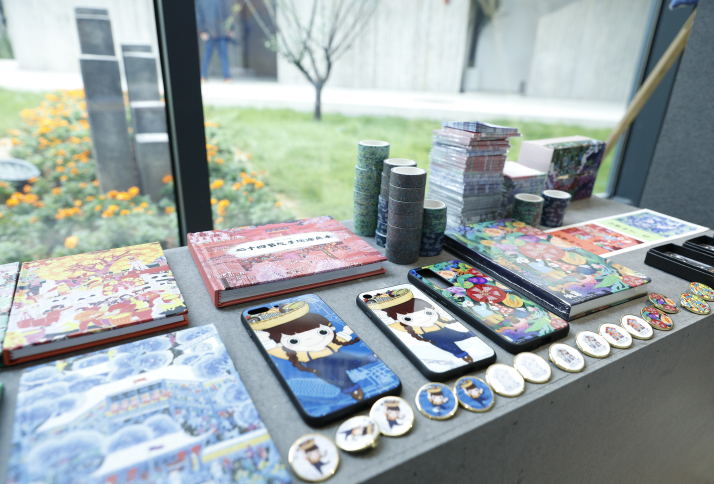When a functional accessory becomes a fun fashion fad

Right after she'd decided to get an iPhone15 following the new model's official launch in early September, Lin Xiaobai, a white-collar worker in Beijing, bought two phone cases online. She even has a storage box that holds more than 80 cases for her used phones.
"Only when the phone is covered by a case, do I feel it is safe," she told Beijing Review. "The cases first served to protect the phones and then, as more designs came out, they became a way to express myself."
She often changes the cases depending on her mood. "Collecting the cases has become a hobby. I go online to look for updated designs, etc.," she said.
Young consumers, caught in a never-ending storm of new smartphone launches, found in the cases an alternative: If they can't afford to upgrade their phones frequently, buying a new case gives them the chance to change the look of their device without breaking the bank.
"Since the new phones of the same brand look quite similar, I was often asked whether I'd bought a new phone when I changed cases," Lin smiled.
Fun(ctional)
Mobile phone cases were initially created for functional purposes. Along with screen protectors, they were designed to protect the phone from scratches and crashes. But gradually, the cases have evolved from their humble beginnings. They have become fashion accessories and customizable platforms for personal expression.
A phone case seller surnamed Wang from Yiwu City in Zhejiang Province, known as the world's capital of small commodities, told Beijing News that the boom in different designs for the cases came along with the boom in smartphones. "To cater to younger groups in particular, many designs, including online game icons, animated images or popular slang, have come out and gone viral," he said. "For example, every year, as the Spring Festival, China's biggest annual holiday, approaches, the design of the New Year's Zodiac animal becomes an instant market hit."
As more manufacturers swarmed into the industry, the price of the cases dropped. "Changing to a new smartphone case is one of the cheapest ways to put me in a good mood," a netizen named Goose wrote on Douban, a popular media review platform in China. "You can find almost any design you want online. If not, you can make one yourself."
In January, Zhang Kaiyi, a makeup and beauty influencer, shared a video of her DIY phone case using colorful cream glue and a range of knickknacks. "Doing this is very soothing," she said in the video. "I love spending a whole day on it."
But it does take some skill to squeeze the glue onto the blank case and then quickly stick the bits and bobs onto the glue. Plus, the finished homemade cases are thicker and heavier than normal ones. One vendor on Alibaba's major online retail app Taobao told Beijing Review that they often sell over 200,000 sets of six differently-hued glues within one month.
"The finished ones are as heavy as a brick, but who cares, I love how it looks," a buyer casually commented online.
Usually, those who spend time designing cases for fun are women; men tend to go for functional features. Many cases now include built-in card holders, kickstands for easy video viewing and even battery packs to extend the phone's battery life.
"Long gone are the days when phone cases served a purely functional purpose," Meng Yao, an industry analyst in Beijing, told Beijing News. "Smartphone cases have undoubtedly undergone a remarkable transformation. Whether it is to keep up with trends or to protect a treasured possession, these cases continue to redefine our relationship with our trusted companions—our smartphones."
To profit or not to profit
The popularity of phone cases used to bring big profits to their manufacturers. Luo Yonghao, founder of Smartisan, a Chinese mobile phone brand that ceased production in 2019, once said that producing phone cases makes much more money than creating smartphones.
This claim is often quoted when talking about the industry's profits, but the phone case business doesn't seem to have been all that profitable in recent years.
The performance of Jame Technology, a leading phone case manufacturer in China founded in 2006, demonstrates just that.
The company's main source of revenue stems from smartphone protection products. In August 2020, it was listed on the Chinese stock market, becoming the first such company in China to do so. However, over the past two years, the company's share price has been steadily declining.
Moreover, it has always been lower than its initial offering price. According to the company's semi-annual report, released in late August, the company's revenue reached 244 million yuan ($33.4 million) in the first half of this year, down 32.22 percent year on year. The company cited several factors for the decline, including fierce industry competition.
With the boom of phone cases, the increasing number of phone case manufacturers has driven down their price, leaving less profit for the manufacturers.
Ma Jihua, founder of DRiSCM Supply Chain Consulting, believes that it is becoming more difficult for the mobile phone case industry to make money. In addition to the fierce competition, with the continuous innovation of smartphones and the emergence of folding screens and other special smartphone models, many manufacturers are also innovating mobile phone protection and reinforcement.
Some young people refuse to use cases, which they consider a waste of money because phone manufacturers have racked their brains to come up with advanced materials that better prevent scratches. Getting a case renders those efforts useless. Plus, these coverings may not be good for phone heat dissipation.
Young people's environmental awareness has also led to a rejection of cases made of materials that are difficult to degrade, including plastics. "This has led case manufacturers to switch to more sustainable materials, such as recycled plastics or materials that are biodegradable," Ma said.